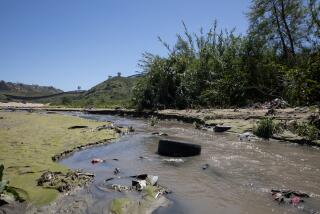2 Steps for a Cleaner Ocean
Actions on both sides of the border in recent days may significantly affect the future quality of ocean water along the coastline of San Diego County and Baja California.
In Tijuana, the Mexican government dedicated with much fanfare the city’s first modern sewage treatment plant; here, the San Diego City Council made the bold decision to forgo any future attempts at getting a waiver from federal requirements that it upgrade its Point Loma sewage treatment plant. The council decided to spend what could be as much as $1 billion to improve the facility.
Although the two projects undoubtedly will lead to cleaner water, both come with questions, in large part relating to money.
The Tijuana plant, which should begin full operation in a month or so, is the long-awaited first step by Mexico to confront the nagging problem of sewage flowing onto San Diego beaches and farmland. Built during a time of severe national economic crisis, the Tijuana treatment plant has earned the praise of U.S. officials as a meaningful beginning in addressing a problem that has become an irritant in relations between the two countries.
When the new plant opens, however, it will be operating at full capacity, and if it is to keep pace with Tijuana’s population growth, it will have to be expanded, or another plant will have to be built.
Some American officials are skeptical that Mexico will make that additional commitment in these difficult economic times.
At this point, it does little good to speculate on how well Mexico will follow through with the next necessary steps. Rather, the Mexican government is to be congratulated on what it has accomplished and what it has pledged to do in the future.
Similarly, the San Diego City Council did not take the easy way out when it voted, 7-1, last week to convert the Point Loma sewage plant to secondary treatment. In making this decision, the council went against the advice of the city’s sewage consultants and the Water Utilities Department, which had favored a continued effort to persuade the U.S. Environmental Protection Agency to grant a waiver in the requirement for secondary treatment.
The hopes for obtaining such a waiver rested on a plan to lengthen the pipe the treated sewage passes through before being discharged so that the effluent would enter the ocean more than a mile farther out to sea. That did not seem like an unreasonable course to pursue, but the council decided the effort would be futile and that it was better to commit now to the upgraded treatment and seek federal and state funds to help pay for it. Mayor Maureen O’Connor shaped the consensus in what may prove to be the most significant accomplishment of her first term in office.
While there is little doubt of the technical merit of taking the Point Loma plant from its current advanced primary treatment to secondary treatment, there are questions about where the money to pay for it will come from. While O’Connor argues that the state and federal governments should pay part of the cost, it remains to be seen whether they will come through with sizable grants.
What does appear likely is that city residents will eventually see at least a threefold jump in their monthly sewage bills from the current average of $8. While no one wants to pay higher utility costs, that kind of increase could have the ancillary benefit of inspiring San Diegans to begin conserving water--something most of us are quite cavalier about considering our semi-arid climate and the impending loss of water imported from the Colorado River.
With efforts also under way to install a system to protect Mission Bay from the incessant sewage spills that have plagued it in recent years, these developments on both sides of the international boundary mean the outlook for cleaner, healthier ocean and beaches is better than it has been in a long time.
More to Read
Sign up for Essential California
The most important California stories and recommendations in your inbox every morning.
You may occasionally receive promotional content from the Los Angeles Times.










